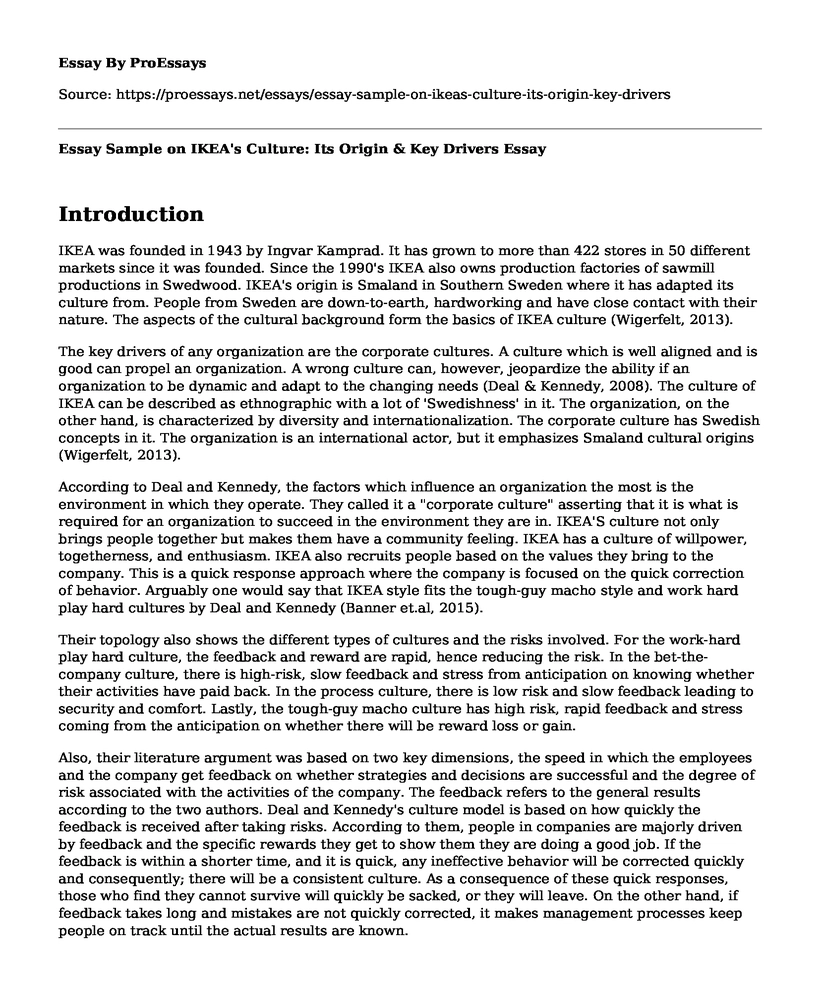Introduction
IKEA was founded in 1943 by Ingvar Kamprad. It has grown to more than 422 stores in 50 different markets since it was founded. Since the 1990's IKEA also owns production factories of sawmill productions in Swedwood. IKEA's origin is Smaland in Southern Sweden where it has adapted its culture from. People from Sweden are down-to-earth, hardworking and have close contact with their nature. The aspects of the cultural background form the basics of IKEA culture (Wigerfelt, 2013).
The key drivers of any organization are the corporate cultures. A culture which is well aligned and is good can propel an organization. A wrong culture can, however, jeopardize the ability if an organization to be dynamic and adapt to the changing needs (Deal & Kennedy, 2008). The culture of IKEA can be described as ethnographic with a lot of 'Swedishness' in it. The organization, on the other hand, is characterized by diversity and internationalization. The corporate culture has Swedish concepts in it. The organization is an international actor, but it emphasizes Smaland cultural origins (Wigerfelt, 2013).
According to Deal and Kennedy, the factors which influence an organization the most is the environment in which they operate. They called it a "corporate culture" asserting that it is what is required for an organization to succeed in the environment they are in. IKEA'S culture not only brings people together but makes them have a community feeling. IKEA has a culture of willpower, togetherness, and enthusiasm. IKEA also recruits people based on the values they bring to the company. This is a quick response approach where the company is focused on the quick correction of behavior. Arguably one would say that IKEA style fits the tough-guy macho style and work hard play hard cultures by Deal and Kennedy (Banner et.al, 2015).
Their topology also shows the different types of cultures and the risks involved. For the work-hard play hard culture, the feedback and reward are rapid, hence reducing the risk. In the bet-the-company culture, there is high-risk, slow feedback and stress from anticipation on knowing whether their activities have paid back. In the process culture, there is low risk and slow feedback leading to security and comfort. Lastly, the tough-guy macho culture has high risk, rapid feedback and stress coming from the anticipation on whether there will be reward loss or gain.
Also, their literature argument was based on two key dimensions, the speed in which the employees and the company get feedback on whether strategies and decisions are successful and the degree of risk associated with the activities of the company. The feedback refers to the general results according to the two authors. Deal and Kennedy's culture model is based on how quickly the feedback is received after taking risks. According to them, people in companies are majorly driven by feedback and the specific rewards they get to show them they are doing a good job. If the feedback is within a shorter time, and it is quick, any ineffective behavior will be corrected quickly and consequently; there will be a consistent culture. As a consequence of these quick responses, those who find they cannot survive will quickly be sacked, or they will leave. On the other hand, if feedback takes long and mistakes are not quickly corrected, it makes management processes keep people on track until the actual results are known.
Conclusion
The key values in IKEA include togetherness, simplicity, caring for the planet and people, cost consciousness and giving and taking responsibility. From the Deal and Kennedy's corporate culture, we see that IKEA has maintained certain factors throughout, despite expanding globally they have stayed afloat. It is, therefore, safe to say that they have the right organizational culture. From the topology by Deal and Kennedy, it can be seen that the culture of IKEA is a good culture.
References
Banner, D. K., Banner, D. K., Gagne, T. E., & Banner, D. K. (2015). Designing Effective
Organizations: Traditional And Transformational Views. Sage. Retrieved from: https://books.google.co.ke/books?id=RVjyaVvEGHoC&printsec=frontcover&dq=isbn:0803948484&hl=en&sa=X&ved=0ahUKEwiS5dfku5TiAhUEJhoKHU9kD6sQ6AEIKDAA#v=onepage&q&f=false
Deal, T. E., & Kennedy, A. A. (2008). The New Corporate Cultures: Revitalizing The Workplace
After Downsizing, Mergers, And Reengineering. Basic Books. Accessed from: https://books.google.co.ke/books?id=-CxHdLPq4wAC&dq=isbn:0786725192&hl=en&sa=X&ved=0ahUKEwjK3pSJvJTiAhUkyYUKHTSfD7oQ6AEIKDAA
Wigerfelt, A. S. (2013). Diversity and Swedishness-A Paradox Within IKEA. International
Journal Of Information Technology And Business Management, 20(1), 1-14. Retreived from: https://www.jitbm.com/20th%20volume/1%20Diversity%20Strategy.pdf
Cite this page
Essay Sample on IKEA's Culture: Its Origin & Key Drivers. (2023, Jan 12). Retrieved from https://proessays.net/essays/essay-sample-on-ikeas-culture-its-origin-key-drivers
If you are the original author of this essay and no longer wish to have it published on the ProEssays website, please click below to request its removal:
- Stolen Without a Gun Ethics Essay
- Stages of Change Management Essay Example
- Essay Sample on Decision-Making Biases and Pitfalls
- Reading a Passage and Answering Questions on Adaptive Leadership
- Essay Example on Social Advocacy: Working to End Discrimination
- Essay on Creating a Gantt Chart: A Guide to Managing the Email Platform Project
- Exploring Ethical Dilemmas: Applying SRM's Decision-Making Model - Essay Sample







